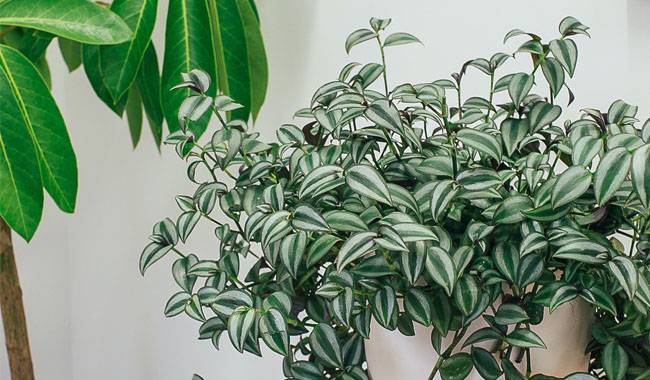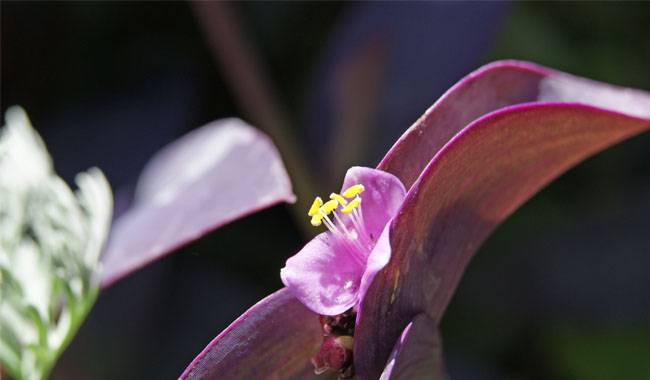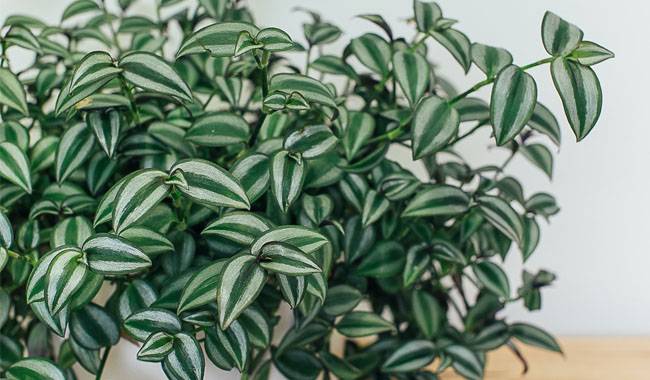
Spiderwort (Tradescantia) is considered to be one of the easiest houseplants to grow. Their fast growth and ample variety ensure that they never go out of fashion. However, they are not tolerant of all conditions. If the basic requirements of lighting or watering are disregarded, Spiderwort will be offended by the rapid loss of decorative qualities. But there can be other reasons for bent, drooping shoots and stunted appearance. To avoid losing your plants, you will need to consider all aspects of care. And act quickly.
Pests of Spiderwort plants
On fleshy shoots of Spiderwort (Tradescantia), the appearance of pests, even at the initial stage, usually show quite obvious symptoms – discoloration, the appearance of spots, death of leaves. There are also bright deformed buds. As a result, the plant loses its decorative character before your eyes.
The most dangerous pests, which most seriously affect the appearance of Spiderwort, are.
- Scab (most often hides on the shoots between the leaves and manifests itself in stunting, accelerated wilting, deformation of shoots and leaves).
- Aphids (in Spiderwort, mainly on young leaves with sticky excrement on which sooty fungi settle).
- Mealybug.
- Thrips.
If you find any traces of pests, you should fight them as soon as possible. Scabies and mealybugs can be removed from leaves and shoots with a cotton pad dipped in soapy water or alcohol, but you still need to treat the plants with insecticides and their analogues. Watering Spiderwort with simple soapy water is ineffective and often causes the same damage to the plant’s appearance, leaving spots.
You can try garlic, dandelion, or pyrethrum infusions to control the pests. If these measures do not work, it is best to treat quickly with an insecticide.
If not pruned
Spiderwort (Tradescantia) ages quickly. They can only benefit from control and pruning. If the plant deforms, elongates, sprouts too long, or the buds become bare, it is important to remember at this point that you can prune the buds as much as you want. Or rejuvenate: If Spiderwort (Tradescantia) is older than 2 years, you should plan to cut it too short stakes in early spring to regenerate it.
Lack of space
Even the most compact Spiderwort (Tradescantia) species are spreading, rather unwieldy plants. They need plenty of space. If bushes are pushed up against glass windows or walls, not to mention other plants, their appearance suffers.
First, leaves and branches can easily be broken. Second, green plants tend to twist, wilt, and look neglected if they have no place to grow. For this reason, Spiderwort plants are best grown in hanging containers or in pots placed on stands or furniture, where the shoots can stretch and grow freely.
There is another important factor in plant deformation due to lack of space: in a small space where air cannot circulate freely, light can become so uneven that parts of the bush can develop differently.
Avoiding the problem is easy: when placing the Spiderwort, make sure that no leaves are leaning on anything; create a kind of “air cushion” around the bush with at least 2-4 inches (5-10 cm) of free space on all sides.
Location change
For Spiderwort (Tradescantia), moving and changing rooms rarely go unnoticed. Trade scans also dislike light-related rotations. Strenuous movements or frequent changes of position related to windows can make them sick. It is best to monitor the pots in relation to the light source, and the effects of the transition can be mitigated.

Insufficient light
Spiderwort (Tradescantia), especially the familiar aloe, is often considered one of the hardiest plants to grow in all conditions. However, a closer look at Spiderwort makes you realize that they are not likely to be shade tolerant.
Spiderwort (Tradescantia) is mainly “colored” or mottled plants. You should never forget the rule that they are better suited to light than green-leaved plants with them. Even in light shade, variegated Spiderwort will lose its color and pattern. So if you want them to decorate your home and not just keep a nice “weed” in the background, consider them to be pro-sun plants and keep them away from windows – if possible, place them on (or near) the eastern and western windowsills. Direct sunlight can cause greenery to burn, but the light must be as bright as possible.
More often than not, Spiderwort canes will deform, lose their shape and become elongated in winter. During dormant periods and when sunlight hours are reduced, they should be moved to the brightest part of the house. Or, if there is no place to move the plants at all, start backlighting.
Temperature extremes
One of the definite advantages of all types and varieties of Spiderwort is their ability to grow equally well in a warm living room and a cool room. They are well adapted to different temperature regimes, and unsuitable temperatures are almost impossible.
The only factor that can cause serious deformation and damage to a shrub is a drop in temperature to well below 50 °F (10 °C). In all other cases, even at high temperatures, severe wilting of the temperature is rarely provoked.
Irrigation problems
This attractive plant likes it if the soil is kept evenly moist. However, for any industry, watering should be regular and appropriate to its needs. Complete drying of the substrate will affect the foliage, and Spiderwort plants will age faster. And over-watering and wetting during watering can lead to the rapid spread of rot.
For perfect results, water your plants only when the soil is dry, to a depth of 1-2 inches (2.5-5 cm) from the top, taking care to avoid water droplets running down onto the leaves. Don’t forget to empty the tray after any more than 5 minutes. In winter, adjust watering according to the temperature and the soil’s drying rate by drying out the substrate twice as much.
No spraying in hot weather
Although they are very adaptable to temperature, Spiderwort will not resist frequent spraying in hot weather – in summer and when the heater is running. But regardless of the season, all species prefer around 60-70% humidity, which is easier to maintain with a tray of moist pebbles or sphagnum soil. Owners signal to themselves to start giving the plant extra humidity and compensate for the discomfort factor by drying their leaf tips.

Spiderwort merchants are stunted if deprived of air
It is no coincidence that Spiderwort (Tradescantia) is so popular in urban landscapes. Outdoors grow several times more vigorously and look brighter. And even indoor beauties are best placed on a patio, garden, or balcony in the summer. Or at least put it in a window that is often hidden from view. If the plant doesn’t get enough fresh air, it will look faded and age more quickly.
Incorrect fertilization
Apply too much fertilizer, especially nitrogen, and Spiderwort will become “fat,” grow vigorously, stretch out and lose its color. Therefore, when feeding these plants, it is worthwhile to aim for a “golden rule.” And follow the basic requirements for pansies strictly.
Fertilize only from March to September, reducing to once every 1.5 months if the plants develop in the fall and winter.
Use the standard frequency of once every 2 weeks.
Choose fertilizers with reduced nitrogen content, higher potassium and phosphorus content, and better micronutrient content.
Problems with soil or containers
If the basic requirements for planting and transplanting are observed, there are hardly any difficulties. These tough plants will wilt and become deformed in the following cases.
- If their pots are extremely oversized when the roots of the plants do not transplant long after they emerge in the drainage holes.
- If there is no drainage hole in the pot, or you forget to place a drainage device at the bottom of the pot.
- If very poor, heavy clay soil is used (almost any light general purpose potting soil will do as long as it is loose enough).
- If the shrub is planted in a very large pot with too much free soil.
- Planted in containers that are too deep (the diameter should be greater than the height, not the other way around)
- If the shrub is heavily flooded during transplanting.
Do not despair even if the tree is severely damaged and only a few poor thin branches remain in the bush. After the damaged parts have been cut off, Spiderwort can easily regenerate with good care. And they grow surprisingly fast. And, by rooting stem plugs in water or sand, new bushes can quickly grow to replace the old ones.







